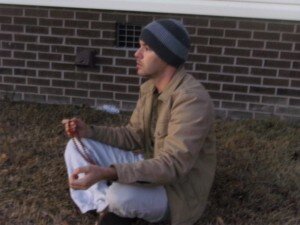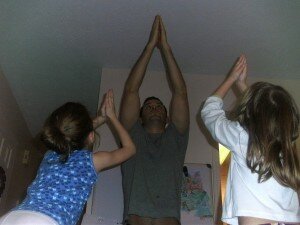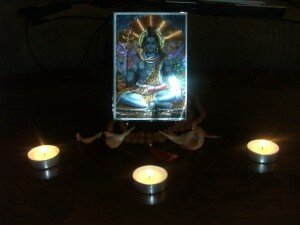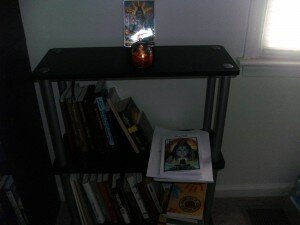Posts Tagged yoga
Month One: Day 27/Hinduism in Review
When I was a kid I hated to try new things. I was a creature of habit. My parents had to make me try new things. “You’ll love soccer, if you tried it out.”
No thanks. I’ll stick to being anti-social and building forts in the woods.
But Mom and Dad had a mission: to expose me to everything they could so that I might develop into a well-rounded young man. Well, I don’t know if I turned cultivated but I did end up liking soccer.
So what’s my point? Project Conversion is an effort to take the lessons my parents taught me about trying new things and looking through the perspectives of others and apply that to the religious violence and bickering that has our world up in flames today. But instead of preaching about it, I decided to show the world how it’s done by putting my money where my mouth is and living it.
One man. Eleven faiths. One year to practice them all. That’s the mission. To live life in the shoes of another. And it started January 1st, 2011 with Hinduism. As promised, here is my review of the month I’ve lived.
What I’ve Learned/What Misconceptions Were Overcome?
“Truth is one, though the wise call it by many names” –the Rig Veda
When I began planning for Project Conversion, my future Jain Mentor told me that “Hinduism is the United States of philosophy.” I didn’t get it at the time but now I understand. Hinduism, like the US of A, is an amalgam of philosophies and theologies joined by a common religious “genetic” ancestor or goal. That’s what is meant by the above quote from the Rig Veda and arguably the whole meaning of Sanatana Dharma.
As I prepared for my month with Hinduism I felt overwhelmed. “So many gods,” I thought. “So many rituals, traditions, and history. Where do I begin?!” Because I grew up as Christian and was accustomed to only one form of God (Jesus) and one scripture (the Bible), the notion that within one religion I had a choice between different deities and holy scriptures was mind-blowing. Truth, it turned out, wasn’t relative, but a singular goal reached by many, many roads. But time was running out and I had to pick a road fast. I selected Shiva as my deity and thus narrowed down how my month would play out.
Shiva is the third aspect of the Supreme Reality (God), Brahman. As Shiva, we understand the creative and destructive cycles of nature. Shiva also represents the detached ascetic, persistent in meditation on the pervasive reality (the divine Self within and outside of us all), and covered in the ashes of burned sin (ignorance). He is represented by the lingam.
The lingam represents the formless, abstract reality of the divine. In Sanatana Dharma, there is freedom to use representations of the divine (murti) in order to meditate and focus on God, however the aspirant is encourage to develop his devotion to the point where such tools and methods are obsolete, as he reaches moksha, the realized state in which all is Brahman–including ourselves.
There are literally thousands of representations of the divine, each for one or more of its aspects. This is why figures like Jesus, the Buddha, and Krishna are all acceptable as projections of the divine within Hinduism. Each are a way to Truth. When I began this month, I clearly thought that Hinduism was a polytheistic faith due to these various representations. Now I know that, depending on which school of thought a Hindu belongs to, they are either monotheists (God exists as a part of and/or outside of creation and selects manifestations) or monist (the divine is manifest in all of creation).
Freedom of devotion also lends to the highly developed artistic acumen of Hindus in general. Their culture is replete with visual, literary, and musical styles that convey every colorful aspect of the divine. One revelation I experienced with this concept is that while Hinduism has its holy texts (i.e., the Vedas, Upanishads, Bhagavad Gita, etc.), spiritual discourse is an ongoing development and the treatises that cover these lessons are held in the same esteem as the rishis (holy men or seers) of time immemorial.
What Would I Do Differently?
For the sake of efficiency, I decided to split each month into four categories: Rituals and practices, arts and culture, social issues, monthly reflection. While this gives a nice introduction into these different aspects of faith, they tend to limit the content I can share about what’s happening with me personally. Let’s face it, if you wanted a scholarly info dump, you could Google the subject and get it anywhere. What makes Project Conversion interesting is that I’m displacing myself for a whole year and living a “day in the life.” Sure, I posted some personal content toward the end and I’ve also kept a hand-written journal of my daily experiences. Going forward, however, I think it would be fair and more beneficial to you if I offered you a more in depth view into my time living as a Hindu, Muslim, Baha’i, etc. So that’s that.
What Am I Taking From This Into The Future?
 One of the most amazing results of Project Conversion was how quickly I was able to adapt. If you would have told me two months ago that I would embrace a vegetarian lifestyle I would have asked you what you were smoking and if I could have some. But now…Understand that Hinduism sees the presence of the divine in all life and all creation. This is why the concept of non-injury is so crucial. Sure, it was tough whenever someone at a restaurant ordered a perfectly seasoned and seared New York strip, the scent of which flooded my nose and thrust me into potential blood-lust. But I resisted. I held fast. And now that I know in vivid detail how meat is transformed from terrified animal to slaughtered flesh on a plate…yeah, I’m a vegetarian now and probably for the long haul. But I won’t judge someone who eats meat. To each their own, right?
One of the most amazing results of Project Conversion was how quickly I was able to adapt. If you would have told me two months ago that I would embrace a vegetarian lifestyle I would have asked you what you were smoking and if I could have some. But now…Understand that Hinduism sees the presence of the divine in all life and all creation. This is why the concept of non-injury is so crucial. Sure, it was tough whenever someone at a restaurant ordered a perfectly seasoned and seared New York strip, the scent of which flooded my nose and thrust me into potential blood-lust. But I resisted. I held fast. And now that I know in vivid detail how meat is transformed from terrified animal to slaughtered flesh on a plate…yeah, I’m a vegetarian now and probably for the long haul. But I won’t judge someone who eats meat. To each their own, right?
Meditation/Yoga. I’m a naturally stressed out guy. As a college student, a father, a husband, a writer, editor, and now in the midst of Project Conversion, it’s easy to see that my head could spin off at any moment. Meditation/yoga–a practice that transcends religious tradition–has become a powerful ally. I am calmer, far more patient, my passion is controlled/guided, and I see the positive in a situation far more readily than in the past. In fact, the results have been so dramatic that I haven’t used profanity(even in thought!) this whole month and even my libido is tamed. Yes, I have a lot further to go, but I like my new disposition and I credit the trained focus of meditation/yoga for that result.
in the midst of Project Conversion, it’s easy to see that my head could spin off at any moment. Meditation/yoga–a practice that transcends religious tradition–has become a powerful ally. I am calmer, far more patient, my passion is controlled/guided, and I see the positive in a situation far more readily than in the past. In fact, the results have been so dramatic that I haven’t used profanity(even in thought!) this whole month and even my libido is tamed. Yes, I have a lot further to go, but I like my new disposition and I credit the trained focus of meditation/yoga for that result.
Saying Goodbye
Adopting Hinduism for the month has been like jumping naked into freezing water. However, now that I’ve lived this way for almost a month, I can honestly say I’m going to miss everything. I don’t want to hang up my rudraksha mala. I want to chant the mantras in the limited Sanskrit I worked so hard to learn. I don’t want to stop visiting the temple and taking part in the classes, aarti, and prasad. I’ll miss the cool sensation of bhasma ash drying on my forehead in the tripundra stripes. The wisdom of the Upanishads has seeped into my heart and mind and though I must now move on, those poetic verses uttered so many millenia ago will echo long beyond my first month of Project Conversion. No, I haven’t presented everything there is to know about Sanatan Dharma here, but then again, that was never the goal. My hope is that you learned enough to want to learn more, to no longer get nervous around a co-worker wearing a bindi or tilak, to ask questions and let one speak for themselves before you judge them.
So here’s to everyone who helped me along the way: Hindu Bhavan Temple, Prof. Bharat Gajjar, Meeta Gajjar Parker, The Naik family, Dr. Gupta and her Sunday School students, Dr. Baktri, everyone who emailed me about the faith and the saints old and new who spoke to me through their written words…
Hinduism/ Week 3: Interview with Professor Bharat J. Gajjar

Interview: Meeta Gajjar Parker
Welcome to Project Conversion, Hinduism! For week 2 of each month, I will focus on the culture and arts associated with that particular faith. I had a chance to speak with singer/songwriter Meeta Gajjar Parker about her life as a Hindu and how it influences her craft.
Andrew Bowen: So, who is Meeta Gajjar Parker?
Meeta Gajjar Parker: I am a recording artist, Vocalist, Yoga Teacher, Writer and some times a healer. And everyday I learn more about who I am.
Andrew Bowen: That’s a great combination. Did one avenue lead to another or did you wake up one day fully realized in what you wanted to do?
Meeta Gajjar Parker: The only thing I ever knew I wanted to do was sing and I knew I was supposed to serve through my gifts. Everything else just happened though there are no accidents. The path is constantly unfolding and reveling to me where I am supposed to go. I’m suppose to roll with it ![]() .
.
Andrew Bowen: Roll with it. I like that. You have a great voice. Were you trained or is it all natural?
Meeta Gajjar Parker: Thank you so much! I took voice lessons but each teacher was very different and wanted different things from me. So I settled by learning how to breathe correctly and applied the technique to everything I wanted to sing. The gift is from God and I treasure it and treat it with great care. So I’d say it is both, trained and natural. The breathing in singing and yoga are the same. Both will get you high on life.
Andrew Bowen: So which served the other? Yoga to singing or visa versa? In the beginning I mean.
Meeta Gajjar Parker: So they are my two favorite things. Both together. I use my voice to raise people’s vibrational frequencies. Frequencies heal, the voice heals and yoga heals. It was song first. The yoga was my secret gift that I could not appreciate full until I was older. Children take yoga for granted because it’s easy for them. Children are natural yogi’s and yogini’s.
Andrew Bowen: Sounds a lot like the concept of Om.
Meeta Gajjar Parker: It is Om. Om is everything in one, yes.
Andrew Bowen: You mentioned your talents as being a gift from God. Do you prescribe to a specific religion or path?And if so, how does it influence your music?
Meeta Gajjar Parker: I am a Hindu. And I am a Shivite; I pray to Shiva. I recorded a chanting CD because I sang chants all my life, that is where music and Hinduism were put in the same place, but Hinduism affects my philosophy on how I handle my life and career more than an influence on my singing. So why did you choose to start with Hinduism?
Andrew Bowen: Honestly, because I thought it was huge and would be difficult so I wanted to get the “hard” one out of the way. But now, it’s like slipping into a warm bath. Is the chanting CD part of your healing work?
Meeta Gajjar Parker: That’s really something, I tend to try to get the things I think are hard out of the way first too. A little, but I worked with Dr. Eric Pearl and he attuned my hands to reconnective frequencies. I find healing emotional problems easier than anything else. Also yoga heals. It’s similar to Reiki. Smiles heal too…
Andrew Bowen: Because the deity Lord Shiva is said to have taught yoga to mankind, it seems like a natural extension for you to be so involved in the art. Are most Shivites this way?
Meeta Gajjar Parker: I don’t know. I think it is not the deity you choose that brings out your gifts, but what line you got in when they were handing gifts out and your ability to see the gifts you have. Let me tell you why I chose Shiva when I was a little girl, but I am devotee of Lord Shiva completely. My dad said I had to choose and he said Shiva got happy easily, so that sounded good to me. My brother chose Krishna. Then we can fight: my God is better than your God.
Andrew Bowen: Are they not both representations of aspects within the nature of Brahman? Or just good old fashion sibling rivalry?
Meeta Gajjar Parker: They are, but this is what children do ![]()
Andrew Bowen: Trust me, with two little ones of my own, I know.
Meeta Gajjar Parker: It would be different if you chose at 18, but children are so close to God. When I was meditating as a child I saw the blue pearl. I only saw it once and never again. My Dad said it’s very rare and people have to be very spiritual to see that.
Andrew Bowen: I think artists in general, especially ones with such talent like yourself, seem to have a form of “third eye” where they see beyond the obvious world. As a fiction writer, I think that’s what attracted me to Shiva. His combination of the concrete and abstract is beautiful. In your experience, are artistic Hindus typically devotees of Shiva?
Meeta Gajjar Parker: I never put the two together and generally people do not tell you who they pray to unless you ask them. But this might be worth delving into further. It could very well be. Yes, I agree with you on that. When I write lyrics, they come from beyond and I believe my third eye and physic center is awakened.
Andrew Bowen: Many artists describe a point as they practice their craft as being in a zone of inspiration. I typically experience it as a displacement, where I am only conscious of the story I’m writing as if the “here and now” no longer applies. Is this the same nature with the goal of meditation and realization of Brahman? Albeit to a lesser extent. This is what gave me the impression that Shiva would be close to the artist’s heart.
Meeta Gajjar Parker: Yes, I think so. I also go into that zone to write lyrics. I go to a special place and let the music tell me the lyrics.
Andrew Bowen: The lyrics for your music with your group, Exotica….
Meeta Gajjar Parker: Your perceptive is unique on that subject. Yes, the lyrics are deep, or I should say have depth. Cookie the Clown has a story too behind the book.
Andrew Bowen: Indeed. Your lyrics with Exotica seem to speak both to the individual and to a wider audience. A sort of within and without. Is this spread of meaning intentional?
Meeta Gajjar Parker: I am trying to up lift with my lyrics, and yes.
Andrew Bowen: As with the chants, are they traditional forms set to new music, or have you blended in new material?
Meeta Gajjar Parker: I sang them like me, but the music is traditional. It was recorded in India with Indian musicians.
Andrew Bowen: They are extremely soothing. As I search for mantras in the form of music, I’ve noticed that many are setting these ancient poems to new genres such as electronic, trance, or even hip-hop. Is this a popular trend within the Hindu community or more of a fringe element?
Meeta Gajjar Parker: It’s actually been going on for a long time. The Krishna Conscious movement was doing that in England, and the Beatles brought it into mainstream as well as Madonna.Yes, mantras change the vibrations of people, raising them up. They can change your mood, remove negativity in a room. They serve the same purpose as the mala bead to take your mind off the negative mind chatter.
Andrew Bowen: I can see that. There is a music video on the site, a rendition of the Tandava Stotram which sets the creative/destructive dance of Shiva to verse, and with that version I can clearly imagine this cosmic dance.
Meeta Gajjar Parker: I’ll have to check that out! Sounds beautiful! BTW I loved your trailer!
Andrew Bowen: Thanks! I hoped folks would enjoy it.
Meeta Gajjar Parker: I’m sure they will as much as I did.
Andrew Bowen: You mentioned writing as well. In fact, you’ve written a children’s book. Mind telling us about that?
Meeta Gajjar Parker: Yes, it’s called “Cookie the Clown.” I worked as Cookie the Clown for 4 years and children kept asking me if I was a real clown and where I came from and I wondered how it would feel to be a real clown and realized that it would feel as different as being a minority. A lot of my inspiration in the book came from my real experiences with the children. So the book is about real clowns that come from a clown country and come and live amongst us. They even have a clown culture and clown abilities and disabilities.
Andrew Bowen: That’s a great plot! Growing up as a Hindu, did you ever feel like a minority in the U.S?
Meeta Gajjar Parker: Yes, no one knew what we were. My Dad was one of the first Indians to come to America when others were going to Britain. The kids teased me and hit me for being different. I guess they were afraid of what they didn’t understand. Just like why you are doing what your doing with Project Conversion. Helping people to understand others.
Andrew Bowen: That is exactly why Project Conversion exists. And I’m sorry you had to go through that. Your father had a lot of courage to come to the U.S. alone.
Meeta Gajjar Parker: His brother came first;, it was my grandfather who had the vision. He believed America was the future not Britain.I think he was right. Do you know I’m the first Female Rock singer of Indian descent?
Andrew Bowen: You just ooze coolness Meeta. Really.
Meeta Gajjar Parker: You’re too kind. Thank you !
Andrew Bowen: No problem. You probably get instant feedback with your yoga and healings, but have you heard from any readers of Cookie the Clown regarding whether or not it helped them as a minority, or maybe even a bully who changed their ways?
Meeta Gajjar Parker: Nope I have not, most people say that the book lifted up their spirits.
Andrew Bowen: I think children’s stories transcend age. As you say, children are very close to the divine.
Meeta Gajjar Parker: Yes that’s true! Big and little people liked the feeling the clowns gave them..
Andrew Bowen: So it looks like you’re a healer on all levels! It’s truly a pleasure to have met you. Any words of advice for me as I continue my journey through Sanatana Dharma?
Meeta Gajjar Parker: Thank you, and for me to have met you! When you meditate, listen with your heart! Everything you ever really need to know is in there.
To hear more of Meeta’s music, visit her Myspace page. For her band, Exotica, go here. Her children’s book, Cookie the Clown, is also available from Amazon.
Hinduism: Day 5
Namaste everyone, and welcome to Day 5 of Project Conversion: Hinduism. As promised, this post will give you an idea of my daily routine as I continue to immerse myself in the deep and majestic faith that is Sanatana Dharma.
6:00 AM
Wake up. Many Hindus begin their day at pre-dawn with a bath or shower (usually said with a prayer to the holy rivers of India) and welcome/praise the sun (embodied as the deity Savitur). This is done with the Gayatri (Guy-ah-tree) Mantra (the mantra itself is personified as the goddess Gayatri Devi, the wife of Brahma) and is usually accompanied by a brief Hatha Yoga (asana or pose-based) form. The Gayathi Mantra is one of the oldest and most sacred in all of Hinduism and is thought to be highly beneficial for all aspects of one’s day. Typically, it’s recited at the three “junctions” of the sun’s path across the sky: dawn, noon, and dusk. Here is the Gayatri Mantra with an English translation:
AUM BHOOR BHUWAH SWAHA,
TAT SAVITUR VARENYAM
BHARGO DEVASAYA DHEEMAHI
DHIYO YO NAHA PRACHODAYAT
“Oh God! Thou art the Giver of Life,
Remover of pain and sorrow,
The Bestower of happiness,
Oh! Creator of the Universe,
May we receive thy supreme sin-destroying light,
May Thou guide our intellect in the right direction.”

Me reciting the Gayatri Mantra at sunset. The Rudraksha Mala (beads) in my hand are used to count each cycle of the recitation (japa).

I perform the Sun Salutation asana sequence (yogic poses) after each of three recitations of the Gayatri Mantra. Here I am showing my daughters how it's done.
Breakfast. Nothing is consumed or done without first acknowledging Brahman (or your deva ishta--personal deity), so no food or water before the morning rituals. Now with that out of the way, I can eat up. Many, if not most, Hindus are vegetarian. That means no meat or meat products (including eggs). This is mainly due to two factors: the concept of ahimsa (the philosophy of non-harming) and that food is placed in one of three gunas (dispositions) of Nature: Sattva, Rajas, and Tamas. Sattva food includes vegetables, nuts, fruits, and rice and is thought to produce positive, non-aggressive energy. Rajas includes red meat and produces apathy. Lastly, Tamas includes hot, spicy foods that, along with Rajas, is thought to produce negative/aggressive energy, anxiety, and restlessness. The reasoning behind this is attributed to the stresses placed on an animal as it is slaughtered being transferred to our bodies in the form of negative energy as we consume its flesh.
This means I have to be a vegetarian…all month. I’ve never done that before because I love meat. How will I survive?!
Actually, it’s not that bad. I’ve done this for 5 days now and I can honestly say that I feel lighter, rejuvenated, and less anxious than usual. My life is pretty hectic with all the projects I have going, not including being a student, a father, and a husband, but here lately the stresses of life have simply rolled from my mind like water off a duck’s back. This is partially due to constant chanting of simple mantras such as Om Namah Shivaya. Something else that helps, in case you just have to have that meat taste, is buying soy “meat” products like this:
There’s a soy “meat” alternative for just about every piece of dead animal you can think of. I had a soy chicken pattie sandwich last night and I kid you not, I couldn’t tell the difference.
Rest of the morning and afternoon:
Huh? What? Don’t sweat it. Sounds complicated and strange…and that’s because it is, however once you throw yourself into the process without reservations, things begin to clear up fast. When I first recieved my “Shiva Puja for Beginners” book I thought my brain would melt out of my ears. It was that complicated--and for beginners! I contacted the author and asked for his advice. His instructions: “Don’t worry. Keep it simple. Do what is comfortable and move on from there.” So I did.
Apart from the noontime recitation of the Gayatri Mantra with some yoga, most Hindus (except the ascetics who hang out in the woods to chant) function like many non-Hindus. If there are any differences, they are culturally based. In Hinduism, knowledge is sacred and seeking it is seen as a form of yoga (union with the divine) called Dnyana. Because Brahman, the Supreme Reality of everything, is in fact all, seeking this Reality through Dnyana Yoga in conjunction with Bhakti Yoga (devotion to a deity) is noble and holy. So, most of my day is spent in the study of Sanatana Dharma by reading holy texts like the Upanishads and Bhagavad Gita, practicing the mantras in Sanskrit, exercizing Ashtanga Yoga (a pose/philosophy- form of yoga based on the “eight limb” philosophy. More on that later), and listening to Hindu mantras set to modern music. Like this one of the Tandava Stotram, a hymn dedicated to Lord Shiva (in the form of Nataraja--the lord of the dance) as he performs the dance of creation and destruction:
Dusk to bedtime:
After performing the dusk Gayatri Matra with Sun Salutation asanas, my family eats dinner. I say my prayers dedicating the food to Brahman while my family say their Christian prayers. Once the kids are tucked into bed, I read more of the holy texts, practice my mantras, and try to clear my mind of the day by focusing on my murti (image, idol) of Shiva. Then, off to bed.
So there you have it: a day with me living as a Hindu. Even just five days in, my wife has noticed a positive difference in me. She might not let me switch-up faiths by the end of the month!
As the month progresses, I will also attend organized communal puja at a local temple and hopefully have some photos and interviews for you to enjoy. But for now, this is me living Hindu, and so far I’m lovin’ it.
Namaste.











Follow Me!